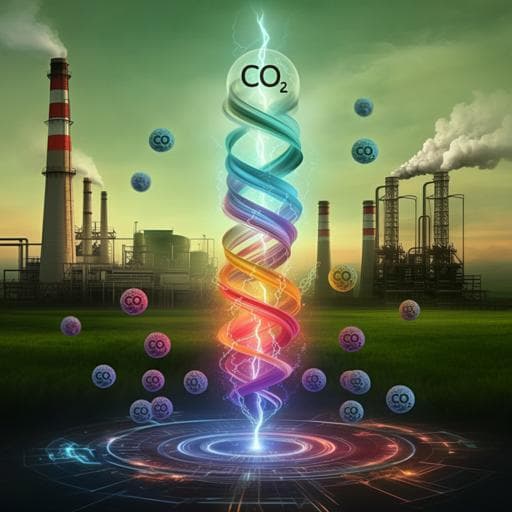
Engineering and Technology
Toward economical application of carbon capture and utilization technology with near-zero carbon emission
K. M. G. Langie, K. Tak, et al.
Explore the revolutionary reaction swing absorption (RSA) technology developed by Kezia Megagita Gerby Langie and colleagues, which promises to produce synthesis gas with near-zero CO2 emissions. This innovative method not only enhances CO2 absorption rates but also significantly cuts down energy costs associated with carbon capture and utilization.
~3 min • Beginner • English
Introduction
The study addresses the challenge of achieving economical and environmentally benign carbon capture and utilization (CCU) by producing syngas with near-zero CO2 emissions. Conventional syngas production routes such as reverse water-gas shift (RWGS) and gas-phase electrochemical CO2 reduction (eCO2R) require costly CO2 capture, high thermal energy input, pressurization, and product separation, compromising their climate benefits and economics. Recent efforts to bypass pre/post-conditioning include using low-concentration CO2 (flue gas) and direct conversion of CO2 captured in amine solutions. However, primary/secondary alkanolamines form carbamates that hinder direct electroreduction; bicarbonate-based approaches (e.g., KOH capture) face corrosion and salt formation, and sustainable supply routes plus system-level assessments (TEA/LCA) remain underdeveloped. The paper proposes reaction swing absorption (RSA) as a process that directly absorbs CO2 from flue gas into an amine as bicarbonate and converts it electrochemically to syngas without thermal regeneration or gas separation, aiming for net-zero emissions when powered by renewables.
Literature Review
Prior work on direct eCO2R in amine capture media showed moderate CO Faradaic efficiencies and revealed that free dissolved CO2, not carbamate-bound CO2, often acts as the active carbon source (e.g., monoethanolamine, diethanolamine). Studies highlighted the limitations imposed by carbamate C–N bond strength and the role of cations in the Helmholtz layer; electrolyte addition can help but adds cost. Bicarbonate conversion systems demonstrated feasibility without added supporting electrolytes and reached high CO selectivity under pressure, proposing KOH as an absorbent; yet, extreme alkalinity raises corrosion and salt formation concerns, challenging commercialization and necessitating sustainable bicarbonate supply. Comprehensive process-level analyses (TEA, LCA) have been lacking for direct-capture conversion systems producing high-pressure syngas. This study builds on these findings by identifying a tertiary amine (triethylamine, TREA) that captures CO2 predominantly as bicarbonate and by integrating experimental performance with system modeling (TEA/LCA/GSA).
Methodology
Concept and process: Defined reaction swing absorption (RSA) comprising chemisorption of CO2 from flue gas to form bicarbonate in an amine solution, liquid-phase pressurization, and electrochemical conversion in a zero-gap MEA electrolyzer. Products (CO/H2) have low solubility in the amine and evolve as purified syngas, obviating thermal solvent regeneration and gas separation.
Amine screening and selection: Primary, secondary, and tertiary amines were screened to favor bicarbonate over carbamate formation. 13C NMR of 3 M TREA/H2O saturated with CO2 showed a single bicarbonate/carbonate peak with no carbamate, consistent with near-neutral pH (7–8) driving bicarbonate formation. A simplified equimolar capture mechanism (CO2 + TREA + H2O → TREAH+ + HCO3–) was proposed; theoretical capacity of TREA exceeds that of monoethanolamine.
CO2 absorption experiments: Bench/pilot-scale packed column (3 m height, 3-inch diameter, Sulzer structured packing) with simulated flue gas (3–5% CO2 in N2/O2) assessed capture performance. Liquid-to-CO2 (L/CO2) ratios of 0.07–0.21 were tested across liquid flows (2–5 L h–1) and gas flows (0.5–0.8 m3 h–1). CO2 capture rates were determined from inlet/outlet CO2 flows at steady state (≥45 min runs). Absorption capacity vs. L/CO2 was analyzed.
Electrochemical system configuration: Commercial MEA electrolyzer (active area 1 cm2) with a bipolar membrane (Fumasep FBM). Catholyte: 3 M TREA saturated with CO2 (pre-bubbled 1 h). Anolyte: 1 M KOH. Cathode: Ag-based catalysts on carbon paper; anode: Ni foam. Gas products routed to the catholyte reservoir and quantified online by GC (TCD/FID; Ar carrier; MolSieve 5A and Hayesep D columns). Chronopotentiometry at -20, -50, -100, -150, -200 mA cm–2. Total Faradaic efficiency confirmed ~100% (CO + H2 only). Bicarbonate concentration tracked over time to identify the carbon source.
Catalyst preparation and characterization: Carbon paper substrates received a 200 nm Ag layer (e-beam evaporation). Ag nanoparticle (Ag NP) inks were spray-coated (with/without Ketjen Black carbon support). Coral-like Ag structures (coral-Ag, coral-Ag/C) formed via electrochemical oxidation in 0.1 M KCl at 0.3 V (Ag/AgCl) for 12 h followed by reduction in 0.1 M KHCO3 at -1.2 V for 30 min. Morphology: SEM/EDX; surface chemistry: XPS. Electrode wettability assessed via water contact angle measurements. Membrane comparisons included anion exchange, cation exchange, and bipolar membranes.
Stability testing: Long-term chronopotentiometry at -100 mA cm–2 for 70 h with coral-Ag/C and bipolar membrane; monitored FE(H2), FE(CO), H2:CO ratio, and cell voltage; checked for CO2 evolution at the anode to assess bicarbonate crossover.
Techno-economic analysis (TEA) and life cycle assessment (LCA): Process modeling integrated experimental performance to compare RSA with RWGS and gas-phase eCO2R. Scenarios: current vs optimistic (improved bicarbonate electrolyzer performance: higher current density, lower voltage, higher CO FE; alternative H2 supply from on-site water electrolysis), varying absorber CO2 capture rates, and electricity sources (energy mix, solar, wind). Metrics: CAPEX, OPEX, break-even syngas price; LCA impacts GWP100 and fossil resource scarcity (FRS) with defined system boundaries including CO2 supply. Global sensitivity analysis (Sobol indices) quantified the influence of uncertain inputs (capture rate, CO FE, current density, electrolyzer unit cost, electricity generation cost, and additional cost for on-site water electrolysis; plus energy mix shares where applicable).
Key Findings
- CO2 capture in TREA as bicarbonate: 13C NMR confirmed bicarbonate as the dominant species with no carbamate detected in 3 M TREA/H2O at pH 7–8; equimolar capture mechanism proposed.
- Absorption performance: High CO2 capture rates from low-concentration flue gas, e.g., 84.5% at 0.8 m3 h–1 gas with 3% CO2 and 95.1% at 0.5 m3 h–1 with 3% CO2. CO2 absorption capacity showed a linear correlation with L/CO2 ratio across tested flows and concentrations.
- Electrochemical conversion with TREA vs alkanolamines: In MEA configuration, 3 M TREA achieved CO FE about 2× higher than 30 wt.% monoethanolamine or diethanolamine across current densities; bicarbonate concentration decreased from 2.78 M to 2.47 M over 6 h of eCO2R, identifying bicarbonate as the carbon source; no CO2 detected in product gas, indicating efficient recapture of unreacted CO2 in solution.
- Catalyst and electrode design: Coral-Ag/C delivered CO FE of 70% at -20 mA cm–2 and 30% at -200 mA cm–2. Improved performance attributed to coral-like Ag structure and increased hydrophilicity of the carbon support (lowest contact angle among tested electrodes), enhancing interaction with liquid-phase carbon source.
- Membrane selection and stability: Bipolar membrane enabled proton/hydroxide supply, minimized ion crossover, and prevented bicarbonate crossover (no anode CO2 evolution). Stable operation at -100 mA cm–2 for 70 h with ~35% CO FE and stable cell voltage.
- Techno-economics: In current scenarios, RSA OPEX and break-even price comparable to RWGS and gas eCO2R but with higher CAPEX due to electrolyzer inefficiency. In optimistic scenarios (improved bicarbonate electrolysis and H2 supply from water electrolysis), RSA outperformed both alternatives in CAPEX, OPEX, and break-even price. With renewable electricity, break-even syngas prices: ~$0.65/kg (wind) and ~$0.56/kg (solar), competitive with fossil-based syngas.
- Environmental performance (LCA): GWP100 minimized to 0.27 kg CO2-eq/kg syngas with wind power; increased to 5.52 kg CO2-eq/kg under current energy mix, reflecting electricity-source sensitivity. FRS trends paralleled GWP due to energy intensity. Sensitivity analysis found electricity price dominant for economics (wind case) and absorber capture rate key for near net-zero emissions; improvements in water electrolysis infrastructure reduce both costs and emissions in energy-mix cases.
Discussion
The RSA approach addresses core barriers to economical and low-emission CO2-to-syngas conversion by coupling selective bicarbonate chemisorption in a tertiary amine (TREA) with direct electrochemical conversion in an MEA. This eliminates thermal solvent regeneration, high-temperature syngas formation, and downstream CO2/product separations. Experimentally, TREA captured CO2 effectively from dilute flue gas and enabled direct bicarbonate utilization at the cathode; hydrophilic, coral-structured Ag on carbon and a bipolar membrane were critical to achieving higher CO selectivity, stable operation, and prevention of carbonate/bicarbonate crossover that destabilizes gas-fed systems. System modeling shows RSA can deliver high-pressure, purified syngas with competitive costs and substantially reduced GWP when powered by renewables. Sensitivity analysis highlights priorities: improving absorber capture rates (to minimize uncaptured CO2), enhancing bicarbonate electrolyzer performance (higher current density, lower voltage, higher CO FE), and leveraging cost-effective, low-carbon electricity (notably wind) alongside efficient on-site water electrolysis for H2 balancing. Collectively, these findings demonstrate a viable path toward near net-zero syngas production from flue gas, enabling downstream exothermic syntheses (e.g., methanol, DME, Fischer–Tropsch) with favorable energy integration.
Conclusion
This work introduces reaction swing absorption (RSA) as a practical, low-emission pathway to produce high-pressure syngas directly from flue gas CO2 by capturing it as bicarbonate in triethylamine and converting it electrochemically. Experiments verified high CO2 capture rates, direct bicarbonate utilization, improved CO selectivity with coral-Ag/C electrodes and bipolar membranes, and multi-tens-of-hours stability. TEA and LCA indicate that, with improved bicarbonate electrolysis and renewable electricity, RSA can achieve competitive syngas prices ($0.56–0.65/kg) and low GWP (as low as 0.27 kg CO2-eq/kg), outperforming RWGS and gas-phase eCO2R. Future research should focus on: scaling and improving bicarbonate electrolyzer performance (current density, voltage, CO FE); robust operation with real flue gas, including impurity (e.g., nitrate) tolerance; optimizing absorber design to maximize capture rate; integrating cost-effective, low-carbon power and on-site water electrolysis for H2 supply; and continued TEA/LCA-driven optimization to guide commercialization.
Limitations
- Current CAPEX for RSA is elevated due to the early-stage, inefficient bicarbonate electrolyzer; improvements are required in voltage, current density, and CO selectivity.
- Environmental performance is highly sensitive to electricity source; using carbon-intensive grids raises GWP substantially.
- Real flue gas impurities (e.g., NO3−) may affect bicarbonate electrolysis and require thorough evaluation before scale-up.
- RSA remains energy-intensive; while electricity can be low-carbon, overall performance depends on absorber capture rate and system integration.
- Operating conditions and system design are not fully optimized; broader validation (larger scales, longer durations) and durability under industrial conditions are needed.
Related Publications
Explore these studies to deepen your understanding of the subject.







